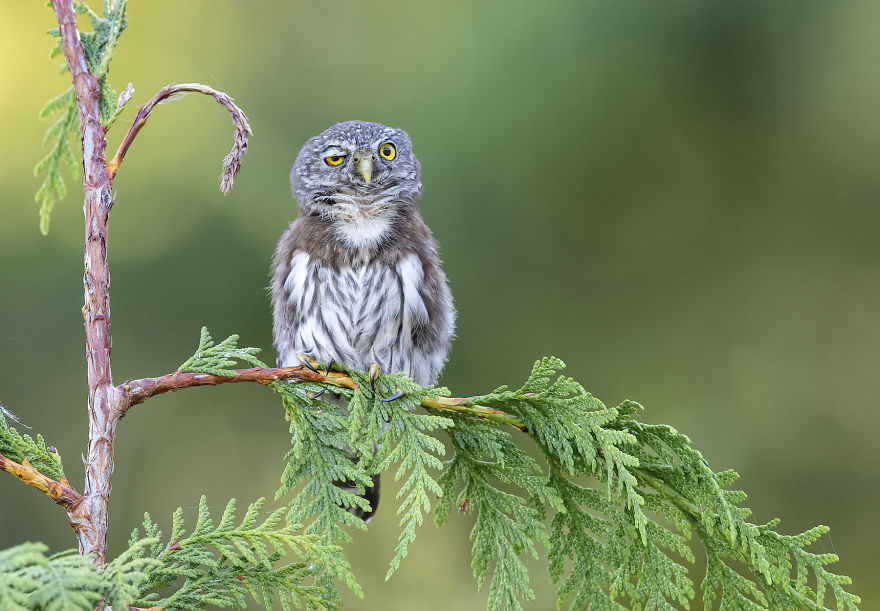Entries are still pouring in from all over the world for this year’s Comedy Wildlife Photography Awards, and here are some of the best images we have received so far! Go on—spread the word and have a laugh on us! The competition, now in its 6th year, runs until June 30th at Midnight BST. We have extended the competition by one month, so now there is no excuse not to enter! Plus, it is still absolutely free to participate! Paul Johnson-Hicks MBE and Tom Sullam co-founded the contest. Both are professional photographers who wanted to create a photographic competition that focused on the lighter side of wildlife, and let’s face it—who can fail to laugh, hoot, and giggle at beautiful wildlife doing impossibly funny things? Still, most importantly, though, the competition’s mission is to promote the conservation of wildlife and their habitats through humorous and light-hearted imagery and a positive message. Through their partnership with the Born Free Foundation, who are once again the official competition partners, they help to ensure that this planet’s wildlife is there for the next generation.
More info: comedywildlifephoto.com | Facebook | Instagram | twitter.com
This post may include affiliate links.
"Rough Night." Northern Pygmy Owl, British Columbia, Canada
There are some fantastic prizes to be won, with the top shot winning a once-in-a-lifetime safari in the Maasai Mara in Kenya with Alex Walker’s Serian, a fabulous Z 6 Nikon and a NIKKOR Z DX 50-250mm f/4.5-6.3 VR lens courtesy of the wonderful people at Nikon, the brilliant no–subscription professional photo editing software from Affinity Photo, a fantastic camera bag from ThinkTank, and the title of 2020 Comedy Wildlife Photographer of the Year. So what are you waiting for? You have until June 30th, 2020 to submit your hilariously funny shots and clips. For more information on how to enter, please visit our website.
"Wowza!" Lion Cub, Masai Mara, Kenya
"Confused." Seal, UK
We are keen to promote our conservation message. The planet has had a bit of a breather recently because most of us have been in lockdown. As a result, we have seen wildlife return and thrive in our rivers, oceans, lands, and skies. It is more important than ever before that we learn from this and make sure we do our best to conserve and look after this amazing planet of ours before it is too late. “What can you do to be a conservationist at home?” We have a whole bunch of ideas, which will be spread out over the year, but we have three wicked ideas that you can tell your friends and families all about:
"Doing The Sand Dance." Brown Bear, Alaska, USA
"Laughing Sea Otter." California, USA
1. SHOP RESPONSIBLY. Yup, this is super easy for everyone to do. Try and buy local produce that is in season and produced sustainably if possible. Avoid non-recyclable products. Shops are getting better at offering alternatives to one-use plastic, for example, but we need to support them.
2. PUT A PLANT BOX ON YOUR WINDOWSILL. Put a plant box on your windowsill, grow some flowers, and give the bees somewhere to go. We’ve all heard of the importance of bees, and this little nod towards their daily requirements is already a massive step in the right direction. Imagine if every windowsill had a flower box! It would be an absolute miracle, so let’s start that process!
3. BECOME A “WILD INFLUENCER.” Yup, you heard it here first. This is a particular person who may be not a mega activist, but really, really cares about the environment and what is happening, and does a few straightforward and easy things. For example, encourage your friends and family about some of the simple things we have mentioned above, talk about it on social media, on Zoom, on the phone. Find awesome conservation organizations and engage with them on email or social media. Email or write to your local government representative, maybe an MP, a House of Rep, a counselor, and find out what they are doing to help the wildlife around the world. Hold your elected representatives accountable. You have a voice, we all do—use it and don’t be afraid! We can make a difference.
"True Name." Yellow Collared Lovebirds, Tarangire National Park, Tanzania
"Laughing Hippo." Mother And A Baby, Masai Mara, Kenya
Hippos look so friendly--especially the young ones--that it is hard to believe how dangerous they are. They are nature's politicians.
"Laughing Stock." Zebra, Nairobi National Park, Kenya
"It's Too Late Roebuck, Too Late." Roebuck Deer, Estonia
"Maestro." Chalky Percher Damselfly, Zambales, Philippines
"Walk On Water." Flamingo, Serengeti, Tanzania
"Lightweight Wrestling." Lions Cubs, Ngorongoro Crater, Tanzania
Well this was disappointing. The only 'comedic' photo was the first one, the owl.
I don’t see how these are ‘comedy wildlife photos’; they’re very cute animals, but that’s all. I liked the maestro dragonfly, though.
Instead of focusing on comedy wildlife, try to promote wildlife/nature conservation. There's nothing funny about dying planet.
Load More Replies...None of these are funny- some idiots decided that any animal with it's mouth open must be laughing and thought it'd make a good title. Likewise animals caught mid-yawn or blink look like they had a rough night. Try harder please.
Well this was disappointing. The only 'comedic' photo was the first one, the owl.
I don’t see how these are ‘comedy wildlife photos’; they’re very cute animals, but that’s all. I liked the maestro dragonfly, though.
Instead of focusing on comedy wildlife, try to promote wildlife/nature conservation. There's nothing funny about dying planet.
Load More Replies...None of these are funny- some idiots decided that any animal with it's mouth open must be laughing and thought it'd make a good title. Likewise animals caught mid-yawn or blink look like they had a rough night. Try harder please.

 Dark Mode
Dark Mode 

 No fees, cancel anytime
No fees, cancel anytime 







































